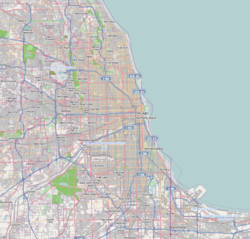Chicago Pile 1
|
Site of the First Self Sustaining Nuclear Reaction
|
|

Drawing of the reactor
|
|
| Location | Chicago, Illinois, US |
|---|---|
| Coordinates | 41°47′32″N 87°36′3″W / 41.79222°N 87.60083°WCoordinates: 41°47′32″N 87°36′3″W / 41.79222°N 87.60083°W |
| Built | 1942 |
| NRHP Reference # | 66000314 |
| Significant dates | |
| Added to NRHP | 15 October 1966 (66000314) |
| Designated NHL | 18 February 1965 |
| Designated CL | 27 October 1971 |
| Chicago Pile-1 (CP-1) | |
|---|---|
| Reactor concept | Research reactor |
| Designed and build by | Metallurgical Laboratory |
| Operational | 1942 to 1943 |
| Status | Dismantled |
| Location | Chicago, Illinois |
| Main parameters of the reactor core | |
| Fuel (fissile material) | Natural uranium |
| Fuel state | Solid (pellets) |
| Neutron energy spectrum | Information missing |
| Primary control method | Control rods |
| Primary moderator | Nuclear graphite (bricks) |
| Primary coolant | None |
| Reactor usage | |
| Primary use | Experimental |
| Remarks | The Chicago Pile-1 (CP-1) is the world's first nuclear reactor. |
Chicago Pile-1 (CP-1), when it achieved criticality, became the world's first artificial nuclear reactor. Its construction was part of the Manhattan Project, the Allied effort to create atomic bombs during World War II. It was built by the Manhattan Project's Metallurgical Laboratory at the University of Chicago, under the west viewing stands of the original Stagg Field. The first human-made self-sustaining nuclear chain reaction was initiated in CP-1 on 2 December 1942, under the supervision of Enrico Fermi, who described the apparatus as "a crude pile of black bricks and wooden timbers".
The reactor was assembled in November 1942, by a team that included Fermi, Leo Szilard (who formulated the idea of the chain reaction), Herbert L. Anderson, Walter Zinn, Martin D. Whitaker, and George Weil. It contained 45,000 graphite blocks weighing 400 short tons (360 t) used as neutron moderators, and was fueled by 6 short tons (5.4 t) of uranium metal and 50 short tons (45 t) of uranium oxide. In the pile, some of the free neutrons produced by the natural decay of uranium were absorbed by other uranium atoms, causing nuclear fission of those atoms, and the release of additional free neutrons. Unlike most subsequent nuclear reactors, it had no radiation shielding or cooling system as it only operated at very low power. The shape of the pile was intended to be roughly spherical, but as work proceeded, Fermi calculated that critical mass could be achieved without finishing the entire pile as planned.
In 1943, CP-1 was moved to Red Gate Woods, and reconfigured to become Chicago Pile-2 (CP-2). There, it was operated until 1954, when it was dismantled and buried. The stands at Stagg Field were demolished in August 1957, but the site is now a National Historic Landmark and a Chicago Landmark.
...
Wikipedia

